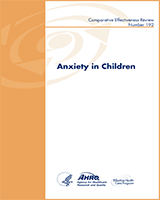From: Appendix G, Subgroup Analysis

Anxiety in Children [Internet].
Comparative Effectiveness Reviews, No. 192.
Wang Z, Whiteside S, Sim L, et al.
Rockville (MD): Agency for Healthcare Research and Quality (US); 2017 Aug.
NCBI Bookshelf. A service of the National Library of Medicine, National Institutes of Health.